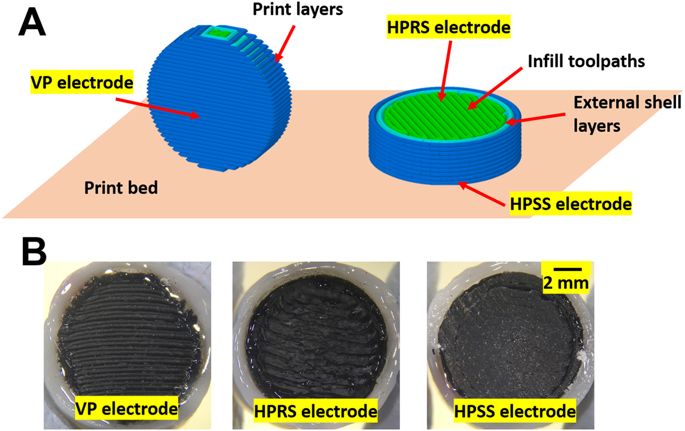 3D printing sensors is an area that is seeing a lot of emerging research. We all know that print orientation can really affect the quality of your prints. Sensors experience this as well with print orientation having been found to have effects on electrochemical behavior. The paper, entitled “The effects of printing on the electrochemical behaviour of 3D printed acrylonitrile butadiane styrine (ABS)/carbon black electrodes,” can be found here.
3D printing sensors is an area that is seeing a lot of emerging research. We all know that print orientation can really affect the quality of your prints. Sensors experience this as well with print orientation having been found to have effects on electrochemical behavior. The paper, entitled “The effects of printing on the electrochemical behaviour of 3D printed acrylonitrile butadiane styrine (ABS)/carbon black electrodes,” can be found here.
The researchers 3D printed a variety of electrodes using both horizontal and vertical printing direction. The horizontal printing direction resulted in a smooth surface for an HPSS (horizontally printed smooth surface) electrode and a relatively rougher surface for an HPRS (horizontally printed rough surface) electrode. The vertically printed electrode showed enhanced current response when compared to the two horizontally printed electrodes, showing that print orientation is in fact a factor in the level of conductivity that a 3D printed object has.
“No differences in the capacitive response was observed, indicating that the conductive surface area of all types of electrodes were identical,” the researchers state. “The VP (vertically printed) electrode had reduced charge transfer resistance and uncompensated solution resistance when compared to the HPSS and HPRS electrodes.”
According to the paper, it’s a challenge to develop electrochemical sensors with complex geometry.
“Composite electrodes are defined as a surface that consists of an ordered arrangement (array) or a random arrangement (ensemble) of conductor regions, typically micrometres in dimension, separated from one another by an insulator,” the researchers explain. “Early composite electrodes were carbon paste electrodes, however over the years various conductive and insulative materials have been utilised.”
Composite electrodes are easy to make in any geometry using 3D printing, and have mechanically robust properies, but their performances vary depending on the differences in the homogeneity of the material and electrode surface from batch to batch. They also have increased resistance compared to solid conductive materials, presenting another challenge to the manufacture of composite electrodes.
3D printing has presented a viable way of fabricating complex electrodes, thanks to the availability of 3D printers and the variety of conductive filaments on the market. Several studies have used 3D printing for sensing, and carbon and metallic materials have been used for 3D printing the electrodes.
“A polystyrene 3D-Printed electrochemical device with embedded carbon nanofiber-graphite-polystyrene composite conductor electrode, showed to have good signal to background voltammetric responses for detection of aqueous Pb2+ via anodic stripping,” the researchers state. “3D printed metal electrodes have been shown to be suitable for the measurement of various analytes, where improved analytical performance and electrode stability compared to glassy carbon electrodes were shown.”
This study specifically was undertaken in order to explore the behavior for ABS/carbon objects that were 3D printed in a horizontal or vertical direction, and found that print orientation does in fact affect how conductive an object will be.
“Overall, our findings indicate that 3D printed conductive materials can produce useful sensors for electroanalytical purposes, and that print orientation can significantly influence the electrochemical behaviour,” the researchers state. “Printing of conductive carbon composite filaments into 3D structures enhanced the electrochemical behaviour of the base material.”
Authors of the paper include Hairul Hisham Bin Hamzah, Oliver Keattch, Derek Covill and Bhavik Anil Patel.
Discuss this and other 3D printing topics at 3DPrintBoard.com or share your thoughts below.
Subscribe to Our Email Newsletter
Stay up-to-date on all the latest news from the 3D printing industry and receive information and offers from third party vendors.
You May Also Like
IperionX Inks 10-Year Deal with Wisconsin Manufacturer for 80 Metric Tons of Titanium Per Year
IperionX, the Charlotte-based supplier of sustainable titanium powders used for additive manufacturing (AM) and metal injection molding (MIM), has signed a ten-year deal with United Stars, a group of industrial...
Gastronology Launches Industrial Production of 3D Printed Food for Dysphagia Patients
Food 3D printing has, in many ways, been an additive manufacturing (AM) segment looking for the right business case. While some applications are beautiful and others may or may not...
Lockheed Martin Leads $3M Investment in Q5D’s Electronics 3D Printing System
Q5D, an original equipment manufacturer (OEM) of robotic arm, hybrid additive manufacturing (AM) systems used for wire harness production, has closed a $3 million investment round. The investment arm of...
3D Printing News Briefs, April 6, 2024: Depowdering, Cybertruck Door Handles, & More
In today’s 3D Printing News Briefs, ioTech’s digital manufacturing CLAD technology is opening up opportunities for microelectronics and additive manufacturing. Hexagon and Raytheon Technologies commercially released the Simufact Additive Process...
































